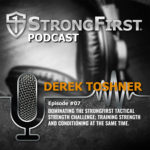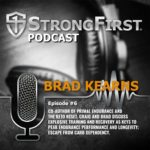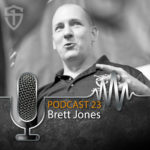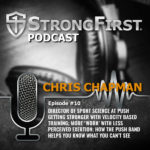StrongFirst Podcast Episode – 03
Summary:
In this episode Craig and Scott interview Dr. Travis Jewett about what it means to move right and to be strong at the same time.
Show Notes:
00:55 Dr. Travis Jewett is a chiropractor, Beast Tamer, SFL and SFG. He teaches the Mobility WOD courses and runs the StrongFirst for Clinicians course. He runs a chiropractic practice in Cherokee, Iowa. About Dr. Travis’s background as a clinician:
- He’s been practicing for almost eleven years.
- Graduated from Palmer College of Chiropractic.
- Was an exercise physiology major at Iowa State.
- He started training relatively young, since he was 12.
- His goal with everything is to take what he’s learned through the years and make sense of how to apply all of it to the people he’s working with.
04:00 How do you integrate moving a load into your clinic and with athletes?
- Most of the people you work with are there for a reason.
- A lot of issues can be traced back to strength capacity issues.
- It has a lot to do with how they move about during their regular day.
04:32 Is movement assessment different than clinical assessment?
- You have to assess whether someone has the flexibility and mobility to do strength movements.
- Most of his assessing people is based around how they’re moving and different ways he can block their behavior.
07:33 What tools do you use in your assessments?
- It depends on the person who’s there.
- He uses whatever tools he needs to do an appropriate assessment.
- A lot of people try to get too specific with what they’re doing.
09:44 What would you say to a patient who is there for a supraspinatus tendonitis, do you avoid a diagnostic description?
- From his standpoint, it’s difficult to make a hard-line diagnosis anyway – you need an imaging correlation.
- All he can tell the person is what he sees in his evaluation.
- Most injuries can be resolved through manual work and strengthening.
12:13 In your practice are you doing more rehab or pre-habilitation?
- People are in your office because the wheels have come off.
- Once the fire is out, they can talk about what it takes to keep moving the needle the right way.
13:45 Talk about common strength training applications in the clinic.
- It all starts from the kettlebell, it’s approachable, the barbell is intimidating.
- Most people he works with are not athletes and that’s not their goal.
- Deadlifts are big, they do a lot of kettlebell deadlifts, and carries.
- For shoulders – floor presses and isometrics.
- A lot of people can’t load overhead, so they begin with isometrics and then arm bars and pieces of the get up to force them to manage the load.
16:50 Talk about isometrics and explain what you’re doing.
- The first part of the get up is laying on the ground and pressing the kettlebell up.
- Isometrics are holding the joint in one position against some sort of external resistance.
- Isometrics can be somewhat pain relieving.
20:15 Explain more about deadlifts for back pain.
- It’s likely that people have put themselves in a compromised position for a long time before they injured.
- It teaches people how to brace around the load and get their whole body tight, you can start to activate and retrain deep reflexive muscles around the spine.
- A lot of people are dealing with chronic or acute pain around the back.
- Putting the spine together before it’s loaded keeps it from being irritated.
- It shows people a better way.
- When someone can hinge without pain, they can perform a deadlift.
- You have to understand that you have to give them exercises and work to do that doesn’t bother them.
28:30 What’s the purpose of bodybuilding flexing?
- If nothing else, it’s fun and training should be enjoyable.
- Flexing is a key component to maintaining muscular health.
- The importance is learning to maintain those sustained isometric contractions.
31:10 Talk more about the Strongman work.
- He and a group are doing a Strongman competition, but the value is moving big loads.
- If you really want to be effective, the farmer walks have to be pretty heavy.
- He teaches people how to pick up sandbags and do tension around them.
- It creates squeezing strength through your trunk musculature.
32:55 Do you have a recent case study you can think of and how you used kettlebells with them?
- A lady with Parkinson’s and the doctors want to do back surgery.
- When disc bulges become a problem, they have to figure out how to get the back to stop hurting.
- They started doing basic kettlebell deadlifts and goblet squats.
- They started doing some sled work.
- Her back is still painful and the degree is way down but more manageable.
- This woman has avoided pain injections and surgery just with three exercises.
36:10 Where do people start who are hearing your message?
- People have to have a whole paradigm shift in how they approach working with other people.
- You have to be willing to explain to your patient base that they don’t need you as much as they think they do.
- Listen to the guys who came before him.
39:27 What is the next step for clinicians?
- StrongFirst for Clinician‘s course offered by StrongFirst is essential.
- The course is to help refine someone who already has a strength background and to elevate the clinician who doesn’t have that background.
42:04 What’s the next step for the non-clinician to prevent injury?
- Get with a clinician who has an understanding of what you’re trying to do – before you have problems.
- Learn about where your bottlenecks might be and how to apply knowledge to your volunteer training.
- Sign up for a workshop, get with a certified instructor, pick up the book Simple & Sinister by Pavel.
45:36 Any closing advice or thoughts?
- If you’re in the world of strength and conditioning, you need to sleep enough.
Tweetable Quotes
We have to get away from labeling people because that can set up their own road blocks to improvement. - Travis Jewett. Click To Tweet
The original reason someone is seeing you is because they’re on fire, not to prevent injury. - Travis Jewett. Click To Tweet
The most important part of the rehabilitation process is pain-free movement. - Travis Jewett. Click To Tweet
Resources Mentioned
Simple & Sinister book by Pavel Tsatsouline
Rdella Training Podcast – Scott’s Podcast
Listen on Stitcher
Listen on Google Play
Download as an MP3 by right-clicking here and choosing “save as.”






Podcasts are great. Looking forward to more.